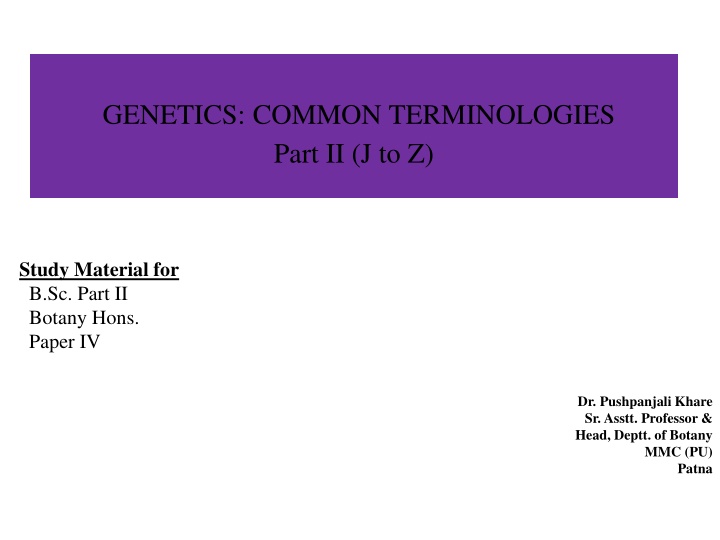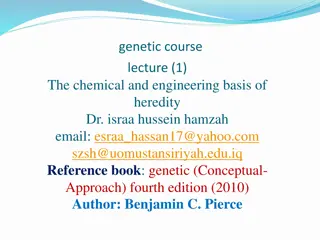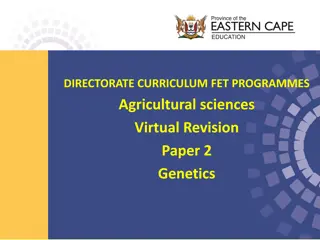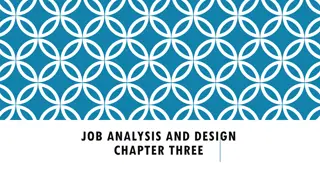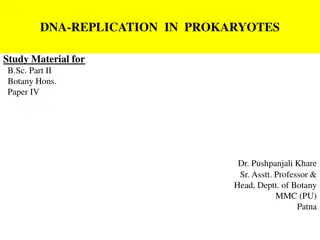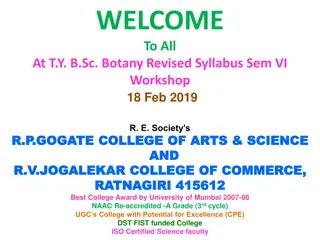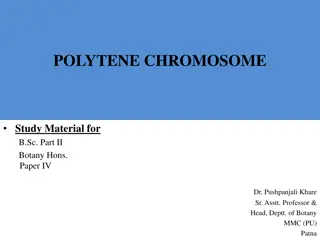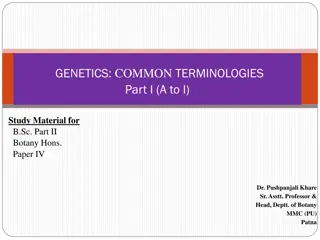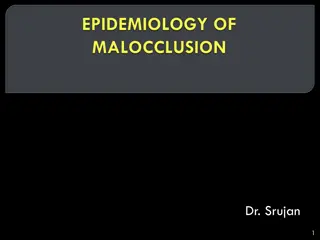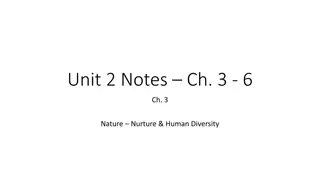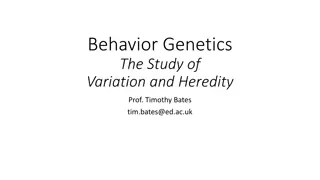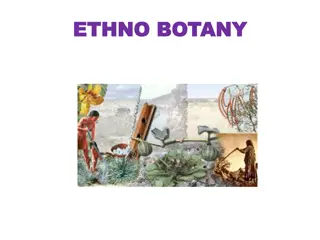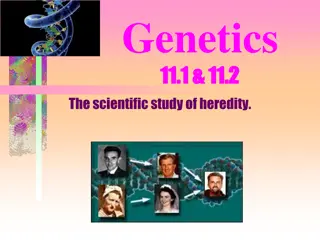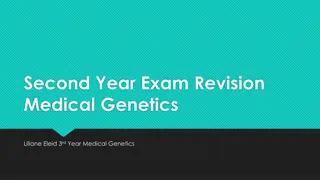Genetics Common Terminologies Part II Study Material for B.Sc. Botany Hons.
Covering a range of genetic terms from J to Z, this study material provides insights into various concepts including gene components, genome elements, DNA regions, chromosome structure, gene relationships, inheritance patterns, and genetic variability. Designed for B.Sc. Botany Hons. students, it explores crucial terminologies essential for understanding genetics.
Download Presentation

Please find below an Image/Link to download the presentation.
The content on the website is provided AS IS for your information and personal use only. It may not be sold, licensed, or shared on other websites without obtaining consent from the author.If you encounter any issues during the download, it is possible that the publisher has removed the file from their server.
You are allowed to download the files provided on this website for personal or commercial use, subject to the condition that they are used lawfully. All files are the property of their respective owners.
The content on the website is provided AS IS for your information and personal use only. It may not be sold, licensed, or shared on other websites without obtaining consent from the author.
E N D
Presentation Transcript
GENETICS: COMMON TERMINOLOGIES Part II (J to Z) Study Material for B.Sc. Part II Botany Hons. Paper IV Dr. Pushpanjali Khare Sr. Asstt. Professor & Head, Deptt. of Botany MMC (PU) Patna
J- K J-CHAIN: It is a protein component of the antibodies IgM AND IgA. It is a 137 residue polypeptide, encoded by the IgJ gene. JUMPING GENE: Transposable element; it is a DNAsequence that can change its position within a genome JUNK DNA: Regions of DNA that are non-coding; it produces non coding RNA, regulatory RNAand ribosomal RNA KAPPA PARTICLES: DNA containing, self-reproducing cytoplasmic particles in certain strains of Paramecium aurelia. They control toxic substance paramecin. KARYOTYPE: The chromosome constitution of a cell or an individual; chromosomes arranged in the order of length and according to position of centromere.
L-M LAMPBRUSH CHROMOSOMES: Large diplotene chromosomes present in oocyte nuclei; particularly conspicuous in amphibians; have extended regions called loops which are sites of transcription. LEPTONEMA: Stage in meiosis immediately after proceeding synapsis in which the chromosome appear as single, fine thread like structure. LETHAL ALLELE:An allele that renders an organism or a cell possessing it inviable. LINKAGE: A relationship among genes in the same chromosome; such genes tend to get inherited together. LINKAGE MAP: A linear or circular diagram that shows the relative position of genes on a chromosome and determined by genetic analysis. LOCUS: A fixed position on chromosome i.e. occupied by a given genes or by one of its alleles. MASS SELECTION:As practiced in plant and animal breeding the choosing of individual for reproduction from the entire population on the basis of individual s phenotypes rather than phenotypes of their relatives. MATERNAL INHERITANCE: Inheritance controlled by extra chromosomal (i.e. cytoplasmic ) factors that are transmitted through the egg.
M MEIOSIS: The process by which the chromosome number of a reproductive cell becomes reduced to half the diploid (2 n) or somatic no; results in the formation of gametes in animals or off spores in plants; important source of variability in recombination. MESSENGER RNA (m RNA): RNA that carries information necessary for protein synthesis from the DNA to the ribosomes. METASTASIS: The spread of cancer cells to previously unaffected organs. MITOSIS: Disjunction of duplicated chromosomes and division of the cytoplasm to produce two genetically identical daughter cells. MODIFIER (MODIFING GENE): A gene that affects the expression of other gene. MONOHYBRID: A cross between parents differing in only one traits. MONOPLOID (HAPLOID): Organism or cell having a single set of chromosome or one genome. MONOSOMIC: A diploid organism lacking one chromosome of its proper complements (2n-1); An aneuploid.; refers to a single chromosome. MONOZYGOTIC TWINS: 1-egg or identical twins. MORPHOGEN: A substance that stimulates the development of form or structure in an organism.
M-N MULTIGENE FAMILY: A group of genes that are similar in nucleotype sequence or that produce polypeptide with similar amino acid sequences. MULTIPLE ALLELES: A condition in which a particular gene occurs in three or more allelic forms in a population of organism. MUTAGENS: An environmental agent, either physical or chemical, that is capable of inducing mutations. MUTANT: A cell or individual organism that shows a change brought about by mutation; A changed gene. MUTATION: A change in the DNA at a particular locus in an organism; Point mutation; Single gene mutation. NUCLEOSOME (NU BODY): Spherical subunits of eukaryotic chromatin that are composed of a core particle consisting of octamer of histones and 146 pair of nucleotide- pairs. NUCLEOTIDE:A unit of DNA and RNA molecules containing a sugar, a phosphate and an organic base. NULL MUTATION: A mutation that abolishes the expression of a gene.
N-O-P NULLISOMIC: An otherwise diploid cell or organism lacking both members of chromosome pairs (2n-2). OPEN READING FRAME: Sequence of nucleotide triplets that the termination codon. OPERATOR: Apart of an Operon that controls the activity of one or more structural genes by binding a regulatory protein. OVER DOMINANCE: A condition in which heterozygotes are superior (on some scale of measurement) to either of the associated homozygotes. PACHYNEMA: A mid prophase stage in meiosis immediately following zygonema and preceding diplonema. PAIR-RULE GENE: Agene that influences the formation of body segments in Drosophila. PALINDROME: A segment of DNA in which the base pair sequence reads the same in both direction from the point of symmetry. PARACENTRIC INVERSION: An inversion which is entirely within one arm of chromosome and does not include centromere. PLASMID: An extra chromosomal hereditary determinant that exists in an autonomous state and is transferred independently of chromosomes.
P POLAR MUTATION: Gene mutation that influences the functioning of genes that are downstream in the same Operon. POLYGENE: One of the many genes involved in quantitative inheritance. POLYMERASE: An enzyme that catalyses the formation of DNA and RNA. POLYMERASE CHAIN REACTION (PCR): A procedure involving multiple cycles of denaturation, renaturation and polynucleotide synthesis that amplifies a particular DNA sequence. POLYMORPHISM: Two or more kinds of individual maintained in a breeding population. POLYPLOID: An organism with more than two sets of chromosomes (2n diploid) or genomes [e.g. Triploid(3n),Tetraploid (4n), Pentaploid (5n) Octoploid(8n)]. POLYTENE CHROMOSOMES: Giant chromosomes produced by interphase replication without division and consisting of many identical chromatids arranged side by side in a cable like pattern. POPULATION GENETICS: The branch of genetics that deals with frequencies of alleles and genotypes in a breeding population. POSITION EFFECT: A difference in phenotype that is dependent on the position of a gene or group of genes, often caused by heterochromatin that is near by. PROGENY TESTING: The practice of ascertaining the genotype of an individual by mating it to an individual of known genotype and examining the progeny.
P-Q-R PROMOTER: A nucleotide sequence to which RNA polymerase binds and initiates transcription. Also a chemical substance that enhances the benign cells into cancerous cells. QUANTITATIVE INHERITANCE: Inheritance of measurable traits (height, weight, color intensity ) that depends on the cumulative action of many genes, each producing a small effect on the phenotype. RANDOM GENETIC DRIFT: Changes in allele frequency in small breeding populations due to chance fluctuation. RECESSIVE: Applied to one member of an allelic pair lacking the ability to manifest itself when the other or dominant member is present. RECIPROCAL CROSSES: Crosses between different strains with the sexes reversed; for example, female A X male B and female B X male A, are reciprocal crosses. REGULATOR GENE: A gene that controls the rate of expression of another gene or genes. Example; the lac eye gene produces a protein that controls the expression of the structural genes of the lac Operon in Escherichia coli. REPLICATION: A duplication process that is accomplished by copying from a template (e.g. reproduction at the level of DNA).
R REPLICON: A unit of replication. In segments of the cell membrane that control replication and co-ordinate it with cell division. RESTITUTION NUCLEUS: An endonuclease that recognizes specific short sequence in DNA and cleaves the DNA molecule. RFLP: Restriction fragment length polymorphism. A genetic difference among individuals that is detected by comparing DNA fragments released by digestion with one or more restriction enzyme. Rh FACTOR: An antigen in the red blood corpuscles of certain people. People with Rh factor in blood are known as Rh positive (+ve) whereas people without Rh factor blood are known as Rh negative (-ve). RNA: Ribonucleic acid; The information carrying material in some viruses; Generally, a molecule derived from DNA by transcription that may carry information (messenger or mRNA), provide subcellular structure (ribosomal or rRNA), transport amino acids (transfer or tRNA), or facilitate the biochemical modification of itself or other RNA molecules. bacteria, replicons are associated with
S S SEGREGATION: The separation of paternal and maternal chromosomes from each other at meiosis; The separation of alleles from each other in heterozygote. SEX LINKAGE: Association or linkage of a hereditary trait with sex; The gene in a sex chromosome, usually the X; Often used synonymously with X-linkage. SOMATIC CELLS: A cell that is a component of the body, in contrast with the germ cell that is capable, when fertilized, of reproducing the organism. SOUTHERN BLOT: the transfer of DNA fragments from an electrophoretic gel to a cellulose or nylon membrane by capillary action. STEM CELL: A mitotically active somatic cell from which other cells arise by differentiation. STRUCTURAL GENE: A gene that specifies the synthesis of a polypeptide SUPERCOIL: A DNA molecule that has twisted. SUPRESSOR MUTATION: A mutation that partially or completely cancels the phenotypic effect of another mutation SYNAPSIS: The pairing of homologous chromosome in the meiotic prophase. SYNAPTINEMAL COMPLEX:A ribbon like structure formed between synapsed homologues at the end of the first meiotic prophase, binding the chromatids along their length and facilitating chromatid exchange.
S SUPRESSOR MUTATION: A mutation that partially or completely cancels the phenotypic effect of another mutation SYNAPSIS: The pairing of homologous chromosome in the meiotic prophase. SYNAPTINEMAL COMPLEX:A ribbon like structure formed between synapsed homologues at the end of the first meiotic prophase, binding the chromatids along their length and facilitating chromatid exchange. SYNDROME: A group of symptoms that occur together and represent a particular disease. SYNKARYON: A nucleus formed by the fusion of nuclei from two different somatic cells during somatic cell hybridization SYNTENY: The occurrence of two loci on the same chromosome, without regard distance between them.
T TELOPHASE: The last stage of each mitotic and meiotic division in which the chromosomes are assembled at the poles of the division spindle. TERMINALIZATION: Repelling movement of the centromeres of the bivalents in the diplotene stages of the meiotic prophase that tends to move the visible chiasmata towards the ends of the bivalents. TEST CROSS: Back cross to the recessive parental type or a cross between genetically unknown individual with a fully recessive tester to determine whether an individual in question is heterozygous or homozygous for a certain allele. Also used as a test for linkage. TETRAD: The four cells arising from the second meiotic division in plants (pollen tetrads) of fungi (blastospores). The term is also used to identify the of chromatids that is formed by the association of duplicated homologous chromosomes during meiosis. TETRAPLOID: An organism whose cells contain four haploid (4n) sets of chromosomes or genomes. TETRASOMIC: Pertaining to a nucleus or an organism with four members of one of its chromosome whereas the remainder of its chromosome complement is diploid (2n+2). TOTIPOTENT CELL (OR NUCEUS): An undifferentiated cell (or nucleus) such as a blastomere that when isolated or suitably transplanted can develop into a complete embryo.
T TRANSGENIC: A term applied to organism that have been altered by introducing DNA molecule into them. TRANSITION: A mutation caused by the substitution of one Purine by another Purine or one Pyrimidine by another Pyrimidine in DNA or RNA. TRANSLOCATION: Change in the position of a segment of a chromosome to another part of the same chromosome or to a different chromosome. TRANSPOSONS: DNA elements that can move ( transpose themselves ) from one position from DNA molecule to another. TRIHYBRID: The offspring from homozygous parents differing in three pair of genes. TRISOMIC: An otherwise diploid cell or organism that has an extra chromosome of one pair (2n+1).
U-V-W-X-Y-Z UNIPARTITE STRUCTURES: Single units. VECTOR: A plasmid or viral chromosome that may be used to construct recombinant DNA molecules for introduction in the living cells. WESTERN BLOT: The transfer of proteins from an electrophoretic gel to a cellulose or nylon membrane by means of an electric force. WOBBLE HYPOTHESIS: Hypothesis to explain how one tRNA may recognize two codons. The first two bases of the mRNA codon and anticodon pair properly, but the third base in the anticodon has some play (wobble) that permits it to pair with more than one base. X-CHROMOSOME:A chromosome associated with sex determination in most animal, the female has two and the male has one X-chromosome. Y- CHROMOSOME: The partner of the X-chromosome in the male of many animal species. ZYGONEMA: Stage in meiosis during which synapsis occurs; after the leptotene stage and before the pachytene stage in the meiotic prophase. ZYGOTE: The cell produced by the union of mature sex cells (gemetes) in reproduction; Also used in genetics to designate the individual developing from such a cell.
Students are requested to share their queries on whatsapp group of class: MMC botany(D2) OR Khare.pushpanjali2@gmail.com OR # 9708063491
